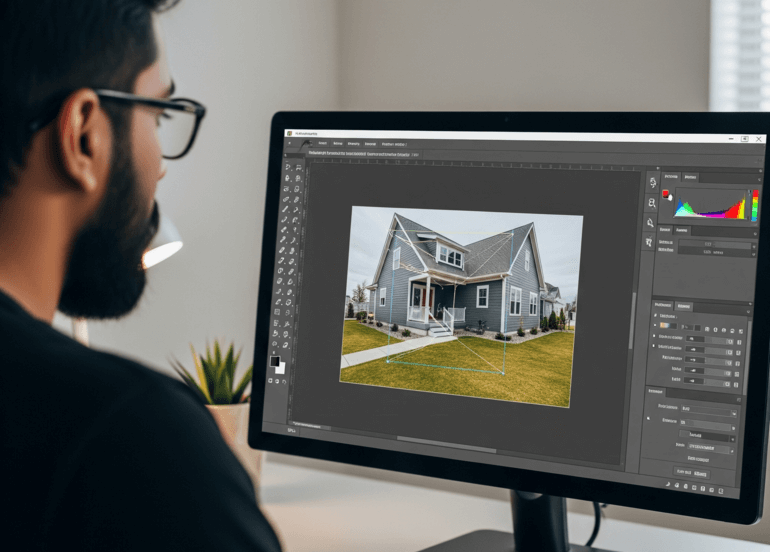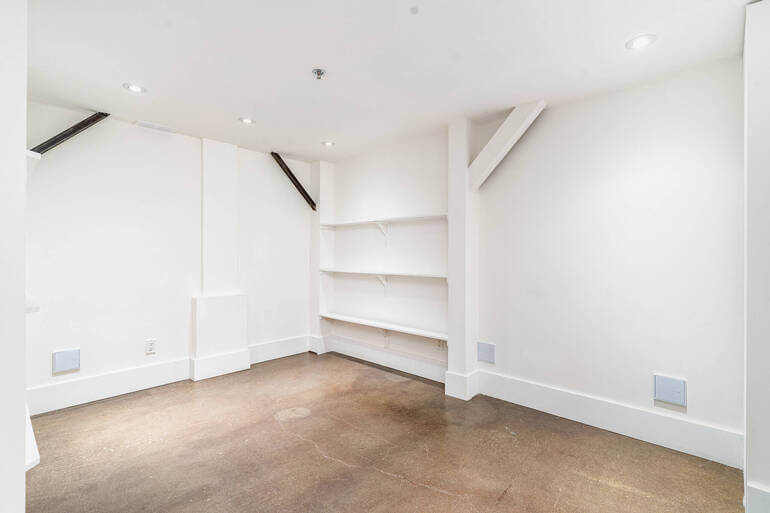Table of Contents
- Why Real Estate Photo Editing Matters More Than Ever
- The Rise of AI Editing Tools
- The Human Touch That AI Tools Can’t Replace
- Comparing AI Real Estate Photo Editing vs Human Editors
- Where AI Often Falls Short
- PhotoUp’s Hybrid Approach: Best of Both Worlds
In today’s real estate market, first impressions happen online—and often within seconds. With 100% of homebuyers starting their search online, the quality of your listing photos can make or break a sale. In fact, properties with professional photos receive 118% more views and can sell up to 32% faster than listings with lower-quality images.
These numbers highlight just how crucial real estate photo editing has become. But with rising demand for quick turnarounds and budget-friendly solutions, a debate has emerged:
Should agents and photographers rely on AI-driven editing tools or human experts?
Let’s explore the strengths and weaknesses of AI and human editors, and why a hybrid approach might be the ultimate solution.
Why Real Estate Photo Editing Matters More Than Ever🏡


Before diving into the AI vs human debate, it’s essential to understand why editing matters so much in real estate marketing.
When potential buyers scroll through listings, they’re not just looking for a house—they’re looking for a home.
Well-edited photos make spaces feel warm, inviting, and aspirational, helping buyers emotionally connect with a property.
Professional real estate photo editing also solves common challenges photographers face:
- Poor lighting or weather conditions on the day of the photoshoot
- Cluttered spaces or distracting objects
- Crooked lines or distorted room perspectives
- And overly bold wall colors that may turn off buyers
Given how quickly a listing can gain or lose attention online, real estate photographers and agents need fast, consistent, and high-quality photo edits to stay competitive.
This is where the battle between AI and human editors begins.
The Rise of AI Editing Tools🤖
Artificial intelligence has made incredible strides, offering speed and automation like never before. Studies show that AI-powered image editing tools can reduce editing time by up to 90%.

However, human editors bring creativity, nuance, and critical thinking that AI can’t fully replicate. The truth is, the future of real estate photo editing may not be one or the other — but rather a blend of both.
Artificial intelligence has transformed many industries, and real estate photo editing is no exception.
Key Advantages of AI Editing

AI-powered software now automates a wide range of tasks, from basic color corrections to more advanced edits like sky replacements and virtual twilight images.
Here are some benefits of AI editing tools:
- Lightning-Fast Turnaround: AI tools can process hundreds of images in minutes, making them ideal for high-volume projects. For instance, some platforms promise edits in as little as 10 seconds per image
- Cost Efficiency: Once the software is set up, the per-image cost is very low compared to hiring a human editor. This makes AI attractive for agents with tight budgets
- Consistency in Simple Tasks: Routine edits, such as exposure balancing, color correction, and lens distortion fixes, can be performed with consistent results, eliminating human error and fatigue
- 24/7 Availability: Unlike humans, AI doesn’t need sleep — making it possible to run edits at any time, day or night
Here are some powerful statistics on AI real estate photo editing to consider:

However, speed and automation come with trade-offs. Let’s take a look at the importance of the human touch that AI can’t replace.
AgentUp for iOS
AI Real Estate Photo Editing
Try instant AI-powered photo editing with the AgentUp iOS Media App.
The Human Touch That AI Tools Can’t Replace👤

While AI excels at repetitive tasks, human real estate photo editors bring creativity and judgment that machines lack.
In real estate, where emotion and storytelling are essential, this human element often makes the difference between a “good” photo and a sale-driving masterpiece.
Why Human Real Estate Photo Editors Are Still Essential for Top-Notch Results
Here are some key aspects that make the human touch essential when enhancing real estate photography:
- Artistic Vision and Style: A skilled real estate photo editor can tailor images to match a client’s brand aesthetic, whether it’s a modern minimalist vibe or a warm, rustic look. AI struggles to interpret these nuanced style requests
- Complex Problem Solving: Challenging edits, such as removing reflections, fixing warped architecture, or creating realistic virtual staging, often require precision and creativity that AI simply doesn’t have
- Quality Assurance: Humans can spot subtle errors, like mismatched lighting in a sky replacement or unnatural shadows, and correct them before final delivery
- Client Collaboration: Real estate marketing is deeply personal. Human editors can work directly with agents and photographers, adapting edits based on feedback — something AI can’t replicate


In the end, AI tools and human editors aren’t rivals—they’re partners. AI provides unmatched speed and efficiency, while humans bring the artistry and precision needed to create truly compelling images.
By combining both, real estate professionals can achieve fast turnarounds without sacrificing quality, ensuring every photo captures a property’s full potential and inspires buyers to take action.
Let’s take a closer look at a comparison between AI vs human editors.
Comparing AI Real Estate Photo Editing vs Human Editors⚖️
| Feature | AI Editing Tools 🤖 | Human Editors 👤 |
| Speed | Very fast, ideal for bulk processing | Slower, but more deliberate |
| Cost | Low cost per image | Higher, depending on project scope |
| Basic Corrections | Good quality and fast results | Very good quality, but slightly slower |
| Handling Complex Edits | Often struggles, may produce artifacts | Highly skilled at problem-solving |
| Creative Direction | Limited | Strong ability to match client vision |
| Revisions & Feedback | Minimal flexibility | Interactive and adaptable |
From this comparison, it’s clear that AI is ideal for basic edits and volume, while humans are indispensable for complex, high-stakes images.
Where AI Often Falls Short🔍

Despite its capabilities, AI has notable weaknesses that can directly impact listing quality:
- Unrealistic Results: AI may produce over-saturated colors, odd shadows, or unnatural textures
- Lack of Contextual Understanding: Machines don’t know that a floating chair or a mismatched window reflection looks wrong
- Difficulty With Unique Properties: Historic homes or unconventional spaces can confuse algorithms trained on standard layouts
- Missed Branding Nuances: AI can’t fully grasp a brokerage’s unique aesthetic or market positioning
For these reasons, relying exclusively on AI can be risky, especially for luxury properties or competitive markets where visual quality matters most.
AI brings speed and scalability, while humans deliver creativity, context, and flawless execution.
Together, they form a powerful team capable of producing the high-quality, visually compelling images today’s competitive real estate market demands.
Have You Ever Thought To
Outsource Photo Editing?
Try it today with 10 free edits from three professional photo editors.
PhotoUp’s Hybrid Approach: Best of Both Worlds✨


At PhotoUp, we’ve perfected the balance between AI efficiency and human craftsmanship.
With our hybrid approach, you don’t have to choose between speed and quality—you get both.
The result? Beautiful, consistent listing photos that captivate buyers and help properties sell faster than ever.
Here’s how our process works:
| AI-Powered Speed: We use AI to perform initial edits, like exposure balancing and basic adjustments, to save time. |
| Human Expertise: Our skilled editors then refine the images, ensuring each photo meets the highest professional standards. |
| Fast Turnaround: This hybrid system allows us to deliver edits within 12-24 hours, even for large projects. |
| Cost-Effective Quality: With plans starting at competitive rates, we help real estate professionals scale without breaking their budget. |
By blending technology with human skill, PhotoUp provides stunning, ready-to-market images that sell properties faster and make clients happy.
Additionally, there are more benefits to using PhotoUp’s services…
Browse Top Dedicated
Real Estate Photo Editors
Ready-to-hire editors for real estate photo editing, and more.
An Ecosystem of Real Estate Marketing Services


On top of a hybrid editing approach, PhotoUp also offers an ecosystem of powerful real estate marketing services, including:
- Virtual staging
- Virtual house tours
- Single property websites
- Floor plans
- House portraits
- And property flyers
As you can see, we have everything you need to enhance and market real estate photography under one roof!
How to Get Started
Getting started is super easy – this is all you need to do:
Step 1. Sign up for a free PhotoUp account.
Step 2. Upload your photos to our easy-to-use software.
Step 3. Choose the level of editing that you need and provide instructions (optional).
Step 4. Wait for PhotoUp professional editors to edit and return the photos in less than 24 hours (48 hours for virtual staging).
Step 5. Download and start using your beautifully edited photos.
PhotoUp Real Estate Photo Editing Uploader Demo
For more information, check out our real estate photo editing uploader demo to see how easy it is to get started:
As simple as that!
Outsourcing to PhotoUp allows you to focus on what you do best—shooting properties—while leaving the editing to the experts.
Sign up for a free PhotoUp account today, and let our team of experts take the editing off your plate with our hybrid approach!
For a limited time, we even offer 10 free credits you can use on any of our services when you sign up for an account.
We hope this blog post highlighted how an AI and human hybrid approach is the solution for top-quality and fast real estate photo editing. If you enjoyed this post, you may also want to check out some related resources:






